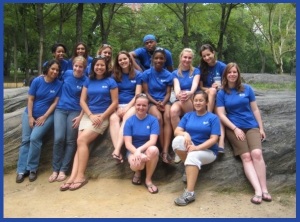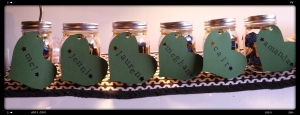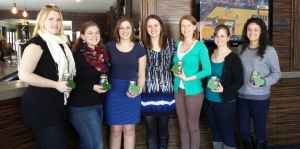Before I started working full-time, I took on internships at a bunch of different places. My first one was at a local newspaper in Trenton, NJ, covering amateur sports events. My second and third internships were both for Simon & Schuster, first in their adult production department, and then for children’s editorial. My last internship before landing a full-time gig was the summer after I graduated college; I spent four days a week with one of Penguin’s children’s editorial teams. Currently, at DK, I hire and manage our seasonal editorial interns. I think I’ve directly managed about six now, maybe more.
All of this is just to say, I know a little bit about internships. Especially publishing internships. I’m sure it was Joni Mitchell who said, “I’ve looked at [internships] from both sides now,” and I, like her, think I have some insight to offer. So, let this post be the first in a series where I discuss how to find, land, and make the most of internships in the publishing industry. I’ll probably also deviate from that plan and talk about what it means to hire, supervise, and mentor interns. I’d love for these posts to turn into discussions from both sides, so feel free to post any questions and thoughts in the comments.
Onward! This post’s topic: Finding internships.
There are so, so many ways to find internships online. From general search sites like Internship Finder and Intern Match, to more specific industry-related sites like Bookjobs and Mediabistro, to even more specific publisher sites, it’s easy to find all sorts of internship opportunities on the web. What’s not easy, though, is actually getting these internships, because everybody is looking at these sites. Everybody. Sometimes hundreds of internship-hopefuls apply for a single internship; you don’t have to be a mathematician to figure out those odds.
I’m not saying you shouldn’t check out these sites — and if you do, know that the industry- and publisher-specific sites are probably your best bet. What you do need to keep in mind, though, is that your leg-up will come from finding internship opportunities in more unlikely locations. As anyone trying to secure their first internship will tell you, every leg-up you can get helps. (They say it’s hard to get an internship without internship experience, and you can’t get internship experience without an internship. They’re right.)
I get it. We’re living in an online world. It’s easy to search, point-and-click, mass-apply. But if the searching, pointing-and-clicking, and mass-applying isn’t working, try one of these five alternatives:
- Talk to your classmates. If you’re in college, chances are good that you have friends, older classmates, or maybe even a lovely creative-writing-club former president (hey, Aly!) who have either completed an internship or are currently interning. I used to love passing along new names and resumes to my old internship coordinators for two reasons: One, it provided me an excuse to get back in touch with HR, which I hoped would keep me fresh in their mind when I started applying for full-time work. And two, it made me feel cool. (What? It did. Haters gonna hate.)
- Talk to your professors. I’m five years removed from college, and I still keep in touch with many of my professors. This is good for you, future interns, because if they ever got in touch with me to recommend someone for DK’s internship, I’d listen. I’d definitely listen. Especially if you’re an English major, it’s likely that your professors have connections at a publishing house, either through friends, former students, or maybe even their own editor. If they like you, maybe they’ll throw you a bone. (Don’t harass them, though. Ask once, ask nicely, then let it go.)
- Go to industry panels. Groups like Young to Publishing (of which I’m a member) have specific committees that travel to colleges, talking up book careers and making connections with publishing hopefuls. If you catch wind of an industry panel at your college, or even at a college nearby, and you don’t attend, you’re just silly. I’ll need to have an entire post devoted to networking etiquette, but for now, the basics: Do your research ahead of time so you know who you’re networking with. Bring copies of your resume but don’t give them out unless they’re asked for. Request business cards from people so you can contact them later. Send thank-you notes or e-mails! (Really! It helps!)
- Find publishers’ career handles and pages on social media. There is a real, live person maintaining these sites, and their entire purpose is to find and connect with you. Facebook pages like Penguin’s and Simon & Schuster’s are great examples. Publishers are on Twitter and Tumblr, too. What’s really great about going this route is last-minute opportunities often get posted; for example, if a Penguin imprint needs an intern to start the next week, you’ll definitely read about it on their newsfeed. It’s worth noting that you should make sure your social media presence shows you in your best light — but, again, that’s another post altogether.
- If you want to edit, read the kind of books you’d want to work on someday. It’s not hard to figure out who the editor is on any book; scan the acknowledgments, go to the author’s website, or check industry listings. Once you’ve got that editor’s name, use your Sherlock Holmes sleuthing skills to devise their publisher’s e-mail address formula (it’s usually along the lines of [firstname].[lastname]@publisher.com, [firstinitial][lastname]@publisher.com… you get the idea). Write them a note introducing yourself, letting them know you enjoyed the book, and asking if they have any internships available. Tread lightly here: Be complimentary, but don’t suck up. Be clear and concise. Send one e-mail, and maybe one follow-up two weeks later if you don’t get a response. Don’t send 20 e-mails a day. (That should go without saying, but sadly… it doesn’t.)

The Simon & Schuster interns of summer 2008 say, “You can do it!”
How did you find your first internship?










